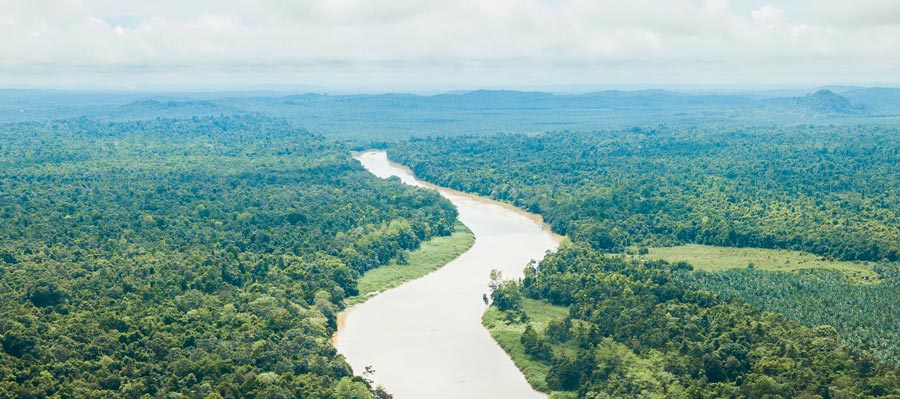



Palm oil production has often been blamed for deforestation in Southeast Asia. However, this does not do any justice to ongoing conservation efforts in Malaysia by both the authorities and non-governmental entities, as well as regional and international organisations.
To address the issue of expanding oil palm plantations, timber production and infrastructural projects, Malaysia has put in place regulations and initiatives related to the conservation and safeguarding of its forests and biodiversity.
Malaysia has about 55% of its land area under forest cover, the conservation of which was confirmed in October 2018 by Primary Industries Minister, the Hon. Teresa Kok. This is in line with Malaysia’s commitment at the 1992 UN Earth Summit in Rio de Janeiro, to retain at least 50% of its land area under forest cover.
With respect to oil palm, Malaysia maintains a policy to limit the area for cultivation at 6 million ha, which is only slightly above the current 5.8 million ha. Also, areas used for other crops, such as rubber, cocoa, tea and rice, are being converted to oil palm plantations, meaning that forests need not be cleared.
Malaysia’s forestry policy was established long before concerns arose with respect to expanding the cultivation of oil palm. The policy originates in the National Forestry Act 1984 (NFA) and National Forestry Policy 1992 (NFP). On those legal bases, Malaysia established Permanent Reserved Forests (PRFs).
The NFP is continuously reviewed, particularly in order to take biodiversity concerns into account. It also provides the institutional framework for cooperation and collaboration between the federal and state governments in the area of forestry development and management.
Malaysia has further established Criteria and Indicators for Forest Plantation Management (i.e. standards for forest management certification, based on the International Timber Tropical Organisation’s Criteria and Indicators, as well as the Forest Stewardship Council’s Principles and Criteria). These are the bases for sustainable forest management.
In recent years, several forest preservation and reforestation projects have been launched by the government, businesses and non-profit organisations. The projects have been supported by regional and international organisations.
At the end of 2016, forested land in the peninsula accounted for 5.8 million ha or 43.8% of Malaysia’s land area of 13.2 million ha. Of this, 4.8 million ha are gazetted as PRFs under the NFA. The PRFs are managed under the sustainable forest management principles and practices for economic, social and environmental benefits.
As at 2016, the Forestry Department of Peninsular Malaysia has maintained 4.5 million ha as forested land, comprising three main forest types – Inland Forest (4.1 million ha), Peat Swamp Forest (0.3 million ha) and Mangrove Forest (0.1 million ha).
Malaysia recently started implementing the ‘Central Forest Spine’ (CFS) master plan with the objective of establishing a contiguous forest network linked through ecological corridors covering around 5 million ha in the peninsula. The CFS, which is composed of four main forest complexes, is an important natural landscape of Malaysia, supplying 90% of the population’s water supply and harbouring the remaining population of Malayan tigers.
As forests often extend across borders, an important aspect of Malaysia’s forest management relates to cross-border cooperation. Peninsular Malaysia shares a border with Thailand; in Borneo, Malaysia shares borders with Indonesia and Brunei. Therefore, the federal government supports the establishment ‘transboundary protected areas’ on a bilateral basis and through the Association of Southeast Asian Nations.

At the regional level, Malaysia is implementing the ‘Heart of Borneo Initiative’. This aims at conserving 20 million ha of forest within Malaysia, Indonesia and Brunei. It is a unique government-led and NGO-supported programme and was initiated on the basis of a joint Declaration by the three governments in 2007.
The Initiative aims at conserving the biodiversity of the ‘Heart of Borneo’ for the benefit of the people who rely on it. The project has established a network of protected areas, sustainable management of forests and sustainable land uses.
In October 2017, as part of the Initiative, the World Wide Fund for Nature (WWF) signed an agreement with the Sabah Forestry Department and the Sabah Wildlife Department to secure and protect key elephant habitats in the transboundary areas. This has found support among local businesses; in 2013, for instance, the plantation company Sabah Softwoods agreed to set aside about 1,050 ha of its land to establish a wildlife corridor to promote connectivity between fragmented forest areas.

Another project is the Bukit Piton Forest Reserve in northern Borneo. From the 1980s to 2007, the forest had been logged and harvested. Additionally, in 1983 and from 1997-98, the area was affected by fires fuelled by drought conditions. This resulted in a degraded forest that might have been converted to agricultural land.
Instead, from 2007, the Sabah Forestry Department, in cooperation with the WWF, began an important reforestation programme. In 2012, the area was reclassified by the Sabah government as a Class I Protection Forest Reserve. This means that the forest is protected by law from any form of land conversion, timber exploitation or extraction of forest products. By now, too, wildlife species like the orang utan have reclaimed the area.
A misinformed debate
There has been increasing global debate on the issue of forest management and deforestation, often triggered by EU stakeholders and held within the European Parliament, and often with a strongly negative and misinformed stance against palm oil.
On April 4, 2017, the European Parliament had adopted a ‘Resolution on Palm Oil and Deforestation of Rainforests’. It states that ‘73% of global deforestation arises from the clearing of land for agricultural commodities, with 40% of global deforestation caused by conversion to large-scale monocultural oil palm plantations’. However, the claim about oil palm is grossly inaccurate.
In 2017, researchers from the French agricultural research and international cooperation organisation CIRAD found that oil palm was not responsible for 40%, but for a mere 2.3% of global deforestation. Its findings highlight where the distortion of facts originated and how it then contributed to the continued use of inaccurate information.
It appears that the figure of 40% originates in a Technical Report published by the European Commission in 2013, entitled ‘The Impact of EU Consumption on Deforestation: Comprehensive analysis of the impact of EU consumption on deforestation’.

The report analysed data from 1990-2008 and stated that, in Indonesia, 25 million ha of forest were lost. Of this 7.5 million ha were used for agricultural production, with 2.9 million ha converted to oil palm plantations. The data, therefore, is clearly restricted to a particular time-period and a single country.
On a global scale, the research notes that 239 million ha of forests were logged from 1990-2008, corresponding to 91 million ha in Latin America, 73 million ha in sub-Saharan Africa, 44 million ha in Southeast Asia and 31 million ha in other parts of the world.
Agriculture was the main cause, with 24% of the land used for livestock breeding and 29% for crop production. Of the total land used for crop production, 19% was attributed to soybean production, 11% to maize, 8% to oil palm, 6% to rice and 5% to sugarcane.
Thus, oil palm cultivation accounted only for 8% of the 29% of global deforestation attributed to crops, corresponding to 2.3% or 5.6 million ha of the 239 million ha of forest lost. Yet the narrative of most commentators still singles out oil palm as the sole ‘culprit’.

Most importantly though, the European Parliament’s Resolution ‘recalls that Malaysia and Indonesia are the main producers of palm oil, with an estimated 85-90% of global production, and welcomes the fact that Malaysian primary forest levels have increased since 1990, but remains concerned that current deforestation levels in Indonesia are running at a rate of -0.5% total loss every five years’.
While the Resolution is mindful of the situation on the ground, public perception is often more general and does not distinguish between individual instances, only thinking along the simplistic line that all palm oil is ‘bad for forests’.
The debate on deforestation must return to the facts and to a more objective foundation. At the same time, it is essential to talk with the countries involved, and not just about them. Often, as is the case for Malaysia, success stories can be told and perhaps serve as a model for other countries.
An open dialogue should ensure that all perspectives are represented. The debate should not be limited to developments in Southeast Asia, but also take account of deforestation in other parts of the world. For instance, forests are still being cleared in central Europe to allow for the extraction of lignite (brown coal) in open-cast mines and to make way for infrastructural development.
Discussion of the fate of global forests must be informed by verified evidence and be conducted in a balanced way. Increased dialogue with global trading partners is essential to set Malaysia’s record straight.
MPOC Brussels